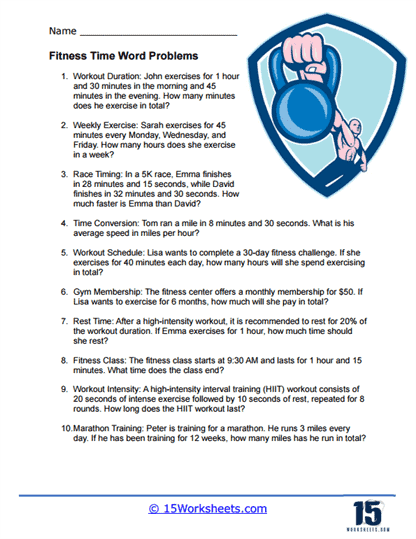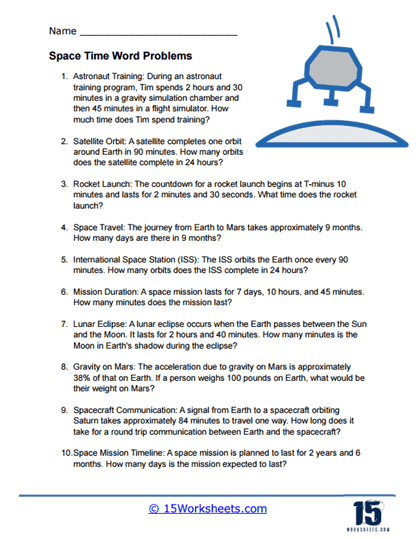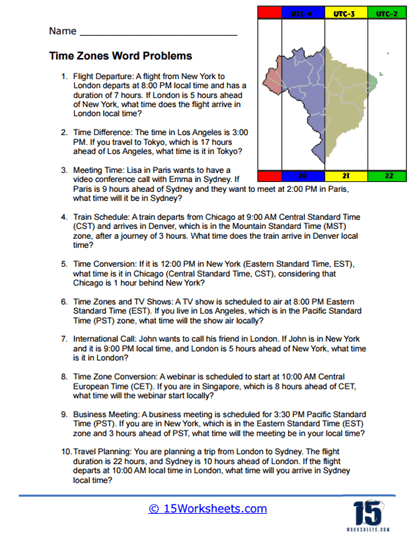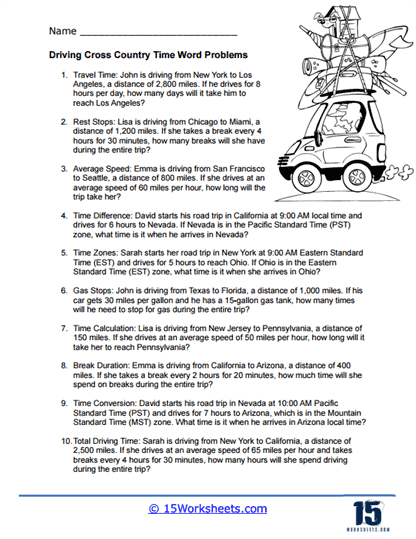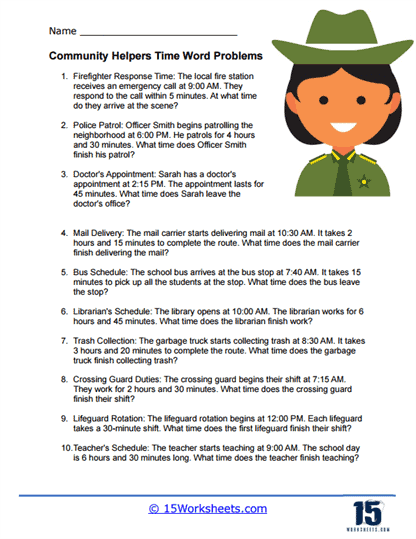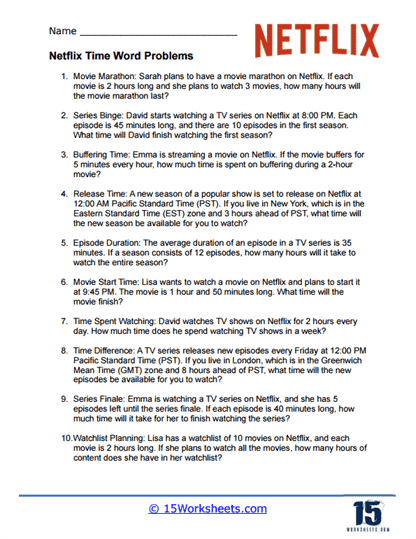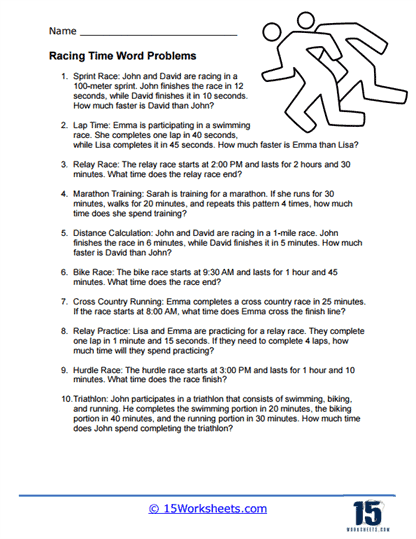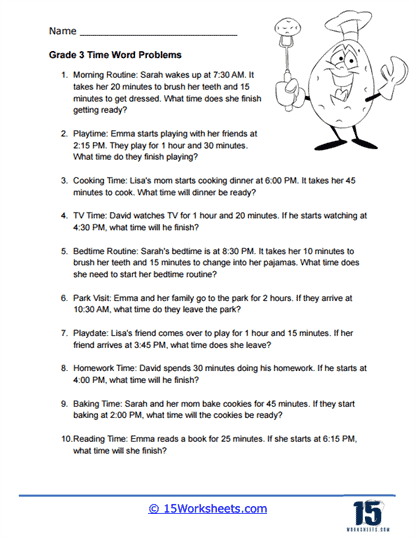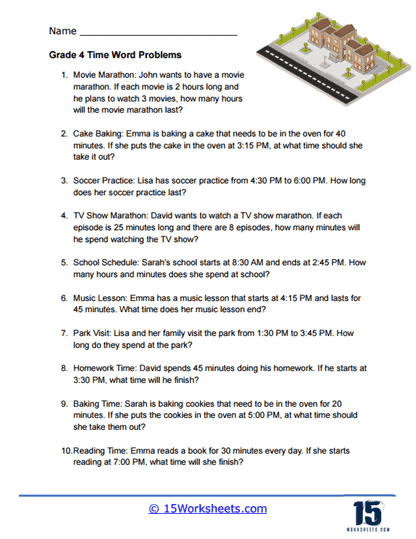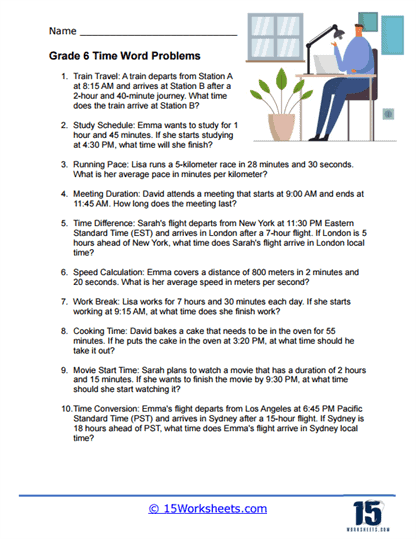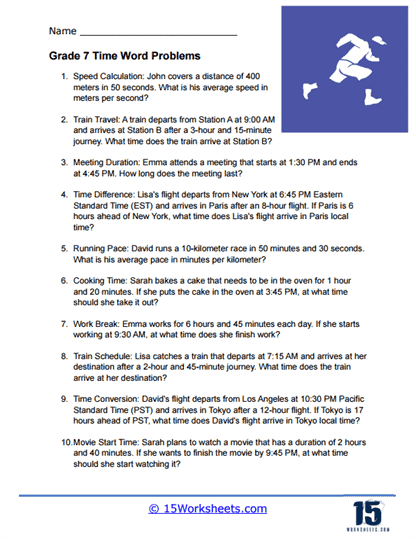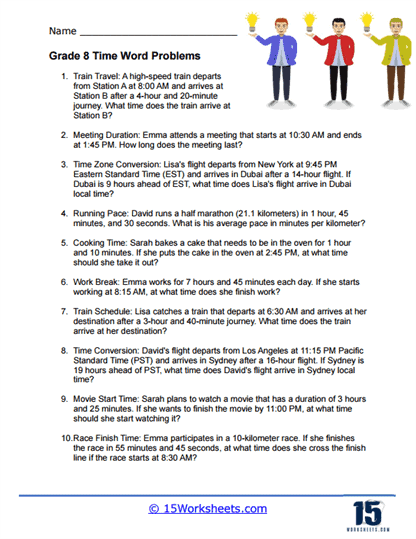Time Based Word Problems Worksheets
About These 15 Worksheets
These worksheets will help students develop their understanding of time-related concepts and improve their skills in solving real-world problems that involve time units, intervals, and calculations. These worksheets provide practical contexts where students can apply their knowledge of time to solve mathematical problems. Time is an essential aspect of everyday life and plays a crucial role in various aspects of mathematics and daily activities, making these worksheets an important component of mathematics education.
Time-based word problem worksheets cover a wide range of topics and complexity levels, making them suitable for different grade levels and skill levels. They can involve tasks such as calculating time intervals, determining time differences, converting between different time units (e.g., hours, minutes, seconds), solving problems related to speed, distance, and time, or solving real-life situations that require time-related calculations. These problems encourage students to interpret written information, identify relevant time values, and perform the necessary time calculations to find solutions.
By working through time-based word problem worksheets, students not only strengthen their understanding of time concepts but also develop critical thinking and problem-solving skills. They learn to apply mathematical principles to practical contexts, improving their ability to make time-related calculations accurately and efficiently in everyday life.
What Are Time Based Word Problems?
Time-based word problems involve situations or scenarios that require solving mathematical problems related to time, such as calculating durations, rates, or time intervals. These problems typically involve units of time, such as hours, minutes, seconds, days, weeks, or years. Time-based word problems can cover various aspects, including travel, work, speed, schedules, and events. Here are some examples of time-based word problems:
Travel and Distance – A common type of time-based problem involves calculating the time taken to travel a certain distance at a given speed. For instance, “If a car travels at an average speed of 60 miles per hour, how long does it take to travel a distance of 240 miles?”
Work and Rates – Time-based word problems can involve rates of work, such as determining how long it takes for two or more people working together or individually to complete a task. For example, “If person A can complete a job in 6 hours and person B can complete it in 4 hours, how long will it take for them to finish the job if they work together?”
Time Intervals – Some time-based problems focus on finding the difference between two given times or calculating durations. For instance, “If an event starts at 10:30 AM and ends at 2:45 PM, how long does the event last?”
Clock Problems – These problems involve questions related to time shown on a clock, such as calculating the angle between the hour and minute hands, or determining the time after a given period of hours and minutes.
Schedules and Timetables – Time-based word problems can also involve interpreting schedules or timetables to determine arrival and departure times, waiting durations, or time overlaps. For example, “If a train leaves at 9:15 AM and arrives at its destination at 1:45 PM, how long is the journey?”
Age Problems – Age-related word problems often involve finding a person’s current age based on their birth year or calculating the age difference between two individuals given their birth dates.
Time Zones – Problems related to time zones might require converting between different time zones or calculating the time difference between two locations.
Examples of Time Based Word Problems
Problem 1 (Easy): Amy started reading a book at 2:15 PM and finished it at 4:30 PM. How long did it take her to read the book?
Solution: To find out how long it took Amy to read the book, you can subtract the starting time from the finishing time.
Starting time: 2:15 PM
Finishing time: 4:30 PM
First, calculate the hours and minutes separately:
Hours: 4 – 2 = 2 hours
Minutes: 30 – 15 = 15 minutes
So, it took Amy 2 hours and 15 minutes to read the book.
Problem 2 (Intermediate): A train departs from City A at 8:45 AM and arrives at City B at 3:15 PM on the same day. How long did the train journey take?
Solution: To find the duration of the train journey, subtract the departure time from the arrival time.
Departure time: 8:45 AM
Arrival time: 3:15 PM
First, calculate the hours and minutes separately:
Hours: 15 (from 3:15 PM) – 8 (from 8:45 AM) = 7 hours
Minutes: 15 minutes
So, the train journey took 7 hours and 15 minutes.
In both examples, we calculate the time difference by subtracting the starting time from the finishing time, considering both hours and minutes. This method allows us to determine the duration or elapsed time accurately.
How to Find Time Difference Manually
Convert the given times to a common format – Ensure that both times are in the same format, whether it’s 12-hour clock (AM/PM) or 24-hour clock. If necessary, convert one of the times to match the format of the other.
Identify the time components – Break down each time into its individual components, which typically include hours, minutes, and seconds. Note down the values for each component.
Calculate the difference between the hours – Subtract the hours of the earlier time from the hours of the later time. Take into account the possibility of the later time being on the next day if the hours are smaller in the earlier time.
Calculate the difference between the minutes – Subtract the minutes of the earlier time from the minutes of the later time. If the minutes of the earlier time are greater than the minutes of the later time, borrow 60 minutes from the hours component and subtract accordingly.
Calculate the difference between the seconds (if applicable) – Follow a similar process as with the minutes, subtracting the seconds of the earlier time from the seconds of the later time, accounting for borrowing from the minutes component if necessary.
Format the result – Express the time difference as a positive value, ensuring that the hours, minutes, and seconds are displayed appropriately. For instance, if the time difference is negative, adjust it by adding 24 hours to the hours component and expressing the result in the same format as the original times.
Consider time zones (if applicable) – If the given times are in different time zones, you may need to account for the time difference between those time zones when calculating the overall time difference.
What is Time Duration?
Time duration refers to the length or span of time between two specific points or events. It represents the amount of time that elapses from a starting point to an endpoint. Time duration is typically measured and expressed in units such as seconds, minutes, hours, days, weeks, months, or years.
Time duration can be used to describe various scenarios:
Event Duration – This refers to the length of time an event or activity lasts. For example, the time duration of a movie, a concert, a sports match, or a meeting.
Task Duration – In project management or task scheduling, time duration is used to estimate or track the time it takes to complete a specific task or activity. It helps in determining timelines, setting deadlines, and allocating resources effectively.
Travel Duration – When referring to travel, time duration represents the time taken to travel between two locations or the length of a journey. It could be the duration of a flight, a road trip, a train ride, or any other form of transportation.
Time Interval – Time duration is also used to describe the length of a time interval between two specific points. This could be the time duration between two events, two points in a timeline, or the time elapsed between a start time and an end time.
Time Spans – Time duration can be used to express the duration of longer periods, such as the duration of a month, a year, or even a specific era or epoch.
What Types of Jobs and Careers Calculate Time Differences Regularly?
Air Traffic Controller – Air traffic controllers work with precise time calculations to manage the flow of air traffic, determine arrival and departure times, and ensure the safe and efficient movement of aircraft.
Pilot or Flight Crew – Pilots and flight crew members need to calculate time differences between departure and arrival locations, taking into account different time zones. This helps in flight planning, managing crew schedules, and coordinating with ground control.
International Business Professionals – Professionals working in international business or global companies frequently deal with time differences when scheduling meetings, conference calls, or coordinating activities across different time zones.
Event Planners – Event planners calculate time differences to schedule events, manage timelines, and coordinate activities that involve participants from different regions or time zones.
Global Customer Support Representatives – Customer support representatives who provide assistance to customers across different time zones need to calculate time differences to ensure they are available during the appropriate business hours and coordinate support activities accordingly.
World Clock Services – Professionals who provide world clock services, time zone conversions, or develop applications related to time zones and time differences need to have expertise in calculating and managing time differences accurately.
Dispatchers – Dispatchers, such as emergency service dispatchers or transportation dispatchers, may need to calculate time differences to coordinate responses, track arrival times, or schedule deliveries across different locations.
Remote Team Managers – Managers of remote teams or distributed teams often deal with time differences to coordinate work schedules, plan meetings, and ensure effective communication among team members in different time zones.
Data Analysts – Data analysts working with global datasets or analyzing time-stamped data often need to calculate time differences to interpret trends, identify patterns, and perform time-based analysis.

